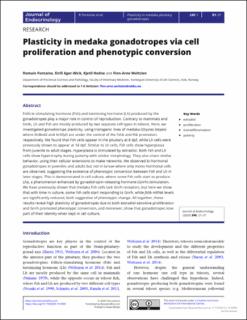| dc.contributor.author | Fontaine, Romain | |
| dc.contributor.author | Ager-Wick, Eirill | |
| dc.contributor.author | Hodne, Kjetil | |
| dc.contributor.author | Weltzien, Finn-Arne | |
| dc.date.accessioned | 2020-11-17T13:16:25Z | |
| dc.date.available | 2020-11-17T13:16:25Z | |
| dc.date.created | 2020-02-15T08:28:41Z | |
| dc.date.issued | 2020 | |
| dc.identifier.citation | Journal of Endocrinology. 2020, 245 (1), 21-37. | en_US |
| dc.identifier.issn | 0022-0795 | |
| dc.identifier.uri | https://hdl.handle.net/11250/2688270 | |
| dc.description.abstract | Follicle-stimulating hormone (Fsh) and luteinizing hormone (Lh) produced by the gonadotropes play a major role in control of reproduction. Contrary to mammals and birds, Lh and Fsh are mostly produced by two separate cell types in teleost. Here, we investigated gonadotrope plasticity, using transgenic lines of medaka (Oryzias latipes) where DsRed2 and hrGfpII are under the control of the fshb and lhb promotors respectively. We found that Fsh cells appear in the pituitary at 8 dpf, while Lh cells were previously shown to appear at 14 dpf. Similar to Lh cells, Fsh cells show hyperplasia from juvenile to adult stages. Hyperplasia is stimulated by estradiol. Both Fsh and Lh cells show hypertrophy during puberty with similar morphology. They also share similar behavior, using their cellular extensions to make networks. We observed bi-hormonal gonadotropes in juveniles and adults but not in larvae where only mono-hormonal cells are observed, suggesting the existence of phenotypic conversion between Fsh and Lh in later stages. This is demonstrated in cell culture, where some Fsh cells start to produce Lhβ, a phenomenon enhanced by gonadotropin-releasing hormone (Gnrh) stimulation. We have previously shown that medaka Fsh cells lack Gnrh receptors, but here we show that with time in culture, some Fsh cells start responding to Gnrh, while fshb mRNA levels are significantly reduced, both suggestive of phenotypic change. All together, these results reveal high plasticity of gonadotropes due to both estradiol-sensitive proliferation and Gnrh promoted phenotypic conversion, and moreover, show that gonadotropes lose part of their identity when kept in cell culture. | en_US |
| dc.language.iso | eng | en_US |
| dc.rights | Attribution-NonCommercial-NoDerivatives 4.0 Internasjonal | * |
| dc.rights.uri | http://creativecommons.org/licenses/by-nc-nd/4.0/deed.no | * |
| dc.title | Plasticity in medaka gonadotropes via cell proliferation and phenotypic conversion | en_US |
| dc.type | Peer reviewed | en_US |
| dc.type | Journal article | en_US |
| dc.description.version | publishedVersion | en_US |
| dc.source.pagenumber | 21-37 | en_US |
| dc.source.volume | 245 | en_US |
| dc.source.journal | Journal of Endocrinology | en_US |
| dc.source.issue | 1 | en_US |
| dc.identifier.doi | 10.1530/JOE-19-0405 | |
| dc.identifier.cristin | 1794342 | |
| dc.relation.project | Norges forskningsråd: 244461 | en_US |
| dc.relation.project | Norges forskningsråd: 243811 | en_US |
| dc.relation.project | Norges forskningsråd: 248828 | en_US |
| cristin.ispublished | true | |
| cristin.fulltext | original | |
| cristin.qualitycode | 1 | |

